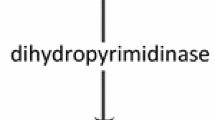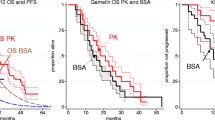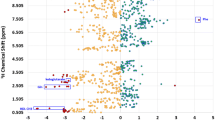Abstract
Purpose
The dihydrouracil (DHU):uracil (U) plasma ratio is a promising marker for identification of dihydropyrimidine dehydrogenase (DPD)-deficient patients. The objective of this study was to determine the effect of liver resection on the DHU:U plasma ratio in patients with colorectal liver metastases (CRLM).
Methods
An observational study was performed in which DHU:U plasma ratios in patients with CRLM were analyzed prior to and 1 day after liver resection. In addition, the DHU:U plasma ratio was quantified in six additional patients 4–8 weeks after liver resection to explore long-term effects on the DHU:U plasma ratio. Quantification of U and DHU plasma levels was performed using a validated ultra-performance liquid chromatography–tandem mass spectrometry (UPLC–MS/MS) assay.
Results
The median (range) DHU:U plasma ratio in 15 patients prior to liver resection was 10.7 (2.6–14.4) and was significantly reduced to 5.5 (< quantification limit (LLOQ-10.5) 1 day after resection (p = 0.0026). This reduction was caused by a decrease in DHU plasma levels from 112.0 (79.8–153) ng/mL to 41.2 (< LLOQ-160) ng/mL 1 day after resection (p = 0.0004). Recovery of the DHU:U plasma ratio occurred 4–8 weeks after liver resection, which was shown by a median (range) DHU:U plasma ratio in six patients of 9.1 (6.9–14.5).
Conclusion
Liver resection leads to very low DHU:U plasma ratios 1 day after liver resection, which is possibly caused by a reduction in DPD activity. Quantification of the DHU:U plasma ratios directly after liver resection could lead to false-positive identification of DPD deficiency and is therefore not advised.


Similar content being viewed by others
References
Torre LA, Bray F, Siegel RL, Ferlay J, Lortet-Tieulent J, Jemal A (2015) Global cancer statistics, 2012. CA Cancer J Clin 65(2):87–108. https://doi.org/10.3322/caac.21262
Haddad AJ, Bani Hani M, Pawlik TM, Cunningham SC (2011) Colorectal liver metastases. Int J Surg Oncol 2011:285840. https://doi.org/10.1155/2011/285840
Borner MM (1999) Neoadjuvant chemotherapy for unresectable liver metastases of colorectal cancer—too good to be true? Ann Oncol 10(6):623–626. https://doi.org/10.1023/A:1008353227103
Mitry E, Fields ALA, Bleiberg H, Labianca R, Portier G, Tu D, Nitti D, Torri V, Elias D, O’Callaghan C, Langer B, Martignoni G, Bouché O, Lazorthes F, van Cutsem E, Bedenne L, Moore MJ, Rougier P (2008) Adjuvant chemotherapy after potentially curative resection of metastases from colorectal cancer: a pooled analysis of two randomized trials. J Clin Oncol 26(30):4906–4911. https://doi.org/10.1200/JCO.2008.17.3781
Heggie GD, Sommadossi JP, Cross DS, Huster WJ, Diasio RB (1987) Clinical pharmacokinetics of 5-fluorouracil and its metabolites in plasma, urine, and bile. Cancer Res 47(8):2203–2206
Judson IR, Beale PJ, Trigo JM, Aherne W, Crompton T, Jones D, Bush E, Reigner B (1999) A human capecitabine excretion balance and pharmacokinetic study after administration of a single oral dose of 14C-labelled drug. Investig New Drugs 17(1):49–56. https://doi.org/10.1023/A:1006263400888
Naguib FN, el Kouni MH, Cha S (1985) Enzymes of uracil catabolism in normal and neoplastic human tissues. Cancer Res 45(11 Pt 1):5405–5412
Mikhail SE, Sun JF, Marshall JL (2010) Safety of capecitabine: a review. Expert Opin Drug Saf 9(5):831–841. https://doi.org/10.1517/14740338.2010.511610
Twelves C, Wong A, Nowacki MP, Abt M, Burris H III, Carrato A, Cassidy J, Cervantes A, Fagerberg J, Georgoulias V, Husseini F, Jodrell D, Koralewski P, Kröning H, Maroun J, Marschner N, McKendrick J, Pawlicki M, Rosso R, Schüller J, Seitz JF, Stabuc B, Tujakowski J, van Hazel G, Zaluski J, Scheithauer W (2005) Capecitabine as adjuvant treatment for stage III colon cancer. N Engl J Med 352(26):2696–2704. https://doi.org/10.1056/NEJMoa043116
Deenen MJ, Meulendijks D, Cats A, Sechterberger MK, Severens JL, Boot H, Smits PH, Rosing H, Mandigers CMPW, Soesan M, Beijnen JH, Schellens JHM (2016) Upfront genotyping of DPYD*2A to individualize fluoropyrimidine therapy: a safety and cost analysis. J Clin Oncol 34(3):227–234. https://doi.org/10.1200/JCO.2015.63.1325
Meulendijks D, Henricks LM, Sonke GS, Deenen MJ, Froehlich TK, Amstutz U, Largiadèr CR, Jennings BA, Marinaki AM, Sanderson JD, Kleibl Z, Kleiblova P, Schwab M, Zanger UM, Palles C, Tomlinson I, Gross E, van Kuilenburg ABP, Punt CJA, Koopman M, Beijnen JH, Cats A, Schellens JHM (2015) Clinical relevance of DPYD variants c.1679T> G, c.1236G> A/HapB3, and c.1601G> A as predictors of severe fluoropyrimidine-associated toxicity: a systematic review and meta-analysis of individual patient data. Lancet Oncol 16(16):1639–1650. https://doi.org/10.1016/S1470-2045(15)00286-7
Jennings BA, Loke YK, Skinner J, Keane M, Chu GS, Turner R, Epurescu D, Barrett A, Willis G (2013) Evaluating predictive pharmacogenetic signatures of adverse events in colorectal cancer patients treated with fluoropyrimidines. PLoS One 8(10):e78053. https://doi.org/10.1371/journal.pone.0078053
Loganayagam A, Arenas Hernandez M, Corrigan A, Fairbanks L, Lewis CM, Harper P, Maisey N, Ross P, Sanderson JD, Marinaki AM (2013) Pharmacogenetic variants in the DPYD, TYMS, CDA and MTHFR genes are clinically significant predictors of fluoropyrimidine toxicity. Br J Cancer 108(12):2505–2515. https://doi.org/10.1038/bjc.2013.262
Lee AM, Shi Q, Pavey E, Alberts SR, Sargent DJ, Sinicrope FA, Berenberg JL, Goldberg RM, Diasio RB (2014) DPYD variants as predictors of 5-fluorouracil toxicity in adjuvant colon cancer treatment (NCCTG N0147). J Natl Cancer Inst 106(12):1–12. https://doi.org/10.1093/jnci/dju298
van Kuilenburg AB, van Lenthe H, Tromp A, Veltman PC, van Gennip AH (2000) Pitfalls in the diagnosis of patients with a partial dihydropyrimidine dehydrogenase deficiency. Clin Chem 46(1):9–17
Pluim D, Jacobs BAW, Deenen MJ, Ruijter AEM, van Geel RMJM, Burylo AM, Meulendijks D, Beijnen JH, Schellens JHM (2015) Improved pharmacodynamic assay for dihydropyrimidine dehydrogenase activity in peripheral blood mononuclear cells. Bioanalysis 7(5):519–529. https://doi.org/10.4155/bio.14.304
van Kuilenburg ABP, Meinsma R, Zoetekouw L, van Gennip AH (2002) Increased risk of grade IV neutropenia after administration of 5-fluorouracil due to a dihydropyrimidine dehydrogenase deficiency: high prevalence of the IVS14+1G>a mutation. Int J Cancer 101(3):253–258. https://doi.org/10.1002/ijc.10599
Milano G, Etienne MC, Pierrefite V, Barberi-Heyob M, Deporte-Fety R, Renée N (1999) Dihydropyrimidine dehydrogenase deficiency and fluorouracil-related toxicity. Br J Cancer 79(3–4):627–630. https://doi.org/10.1038/sj.bjc.6690098
van Kuilenburg AB, Haasjes J, Richel DJ, Zoetekouw L, van Lenthe H, de Abreu RA, Maring JG, Vreken P, van Gennip A (2000) Clinical implications of dihydropyrimidine dehydrogenase (DPD) deficiency in patients with severe 5-fluorouracil-associated toxicity: identification of new mutations in the DPD gene. Clin Cancer Res 6(12):4705–4712
Fleming RA, Milano G, Thyss A, Etienne MC, Renée N, Schneider M, Demard F (1992) Correlation between dihydropyrimidine dehydrogenase activity in peripheral mononuclear cells and systemic clearance of fluorouracil in cancer patients. Cancer Res 52(10):2899–2902
Gamelin E, Boisdron-Celle M, Guérin-Meyer V, Delva R, Lortholary A, Genevieve F, Larra F, Ifray N, Robert J (1999) Correlation between uracil and dihydrouracil plasma ratio, fluorouracil (5-FU) pharmacokinetic parameters, and tolerance in patients with advanced colorectal cancer: a potential interest for predicting 5-FU toxicity and determining optimal 5-FU dosage. J Clin Oncol 17(4):1105–1110. https://doi.org/10.1200/JCO.1999.17.4.1105
Jiang H, Lu J, Jiang J, Hu P (2004) Important role of the dihydrouracil/uracil ratio in marked interpatient variations of fluoropyrimidine pharmacokinetics and pharmacodynamics. J Clin Pharmacol 44(11):1260–1272. https://doi.org/10.1177/0091270004268911
Sistonen J, Büchel B, Froehlich TK, Kummer D, Fontana S, Joerger M, van Kuilenburg ABP, Largiadèr CR (2014) Predicting 5-fluorouracil toxicity: DPD genotype and 5,6-dihydrouracil:uracil ratio. Pharmacogenomics 15(13):1653–1666. https://doi.org/10.2217/pgs.14.126
Zhou ZW, Wang GQ, Wan DS, Lu ZH, Chen YB, Li S, Chen G, Pan ZZ (2007) The dihydrouracil/uracil ratios in plasma and toxicities of 5-fluorouracil-based adjuvant chemotherapy in colorectal cancer patients. Chemotherapy 53(2):127–131. https://doi.org/10.1159/000099984
Boisdron-Celle M, Remaud G, Traore S, Poirier AL, Gamelin L, Morel A, Gamelin E (2007) 5-Fluorouracil-related severe toxicity: a comparison of different methods for the pretherapeutic detection of dihydropyrimidine dehydrogenase deficiency. Cancer Lett 249(2):271–282. https://doi.org/10.1016/j.canlet.2006.09.006
Meulendijks D, Henricks LM, Jacobs BAW, Aliev A, Deenen MJ, de Vries N, Rosing H, van Werkhoven E, de Boer A, Beijnen JH, Mandigers CMPW, Soesan M, Cats A, Schellens JHM (2017) Pretreatment serum uracil concentration as a predictor of severe and fatal fluoropyrimidine-associated toxicity. Br J Cancer 116(11):1415–1424. https://doi.org/10.1038/bjc.2017.94
Snoeren N, van Hillegersberg R, Schouten SB, Bergman AM, van Werkhoven E, Dalesio O, Tollenaar RA, Verheul HM, van der Sijp J, Borel Rinkes IH, Voest EE, Hepatica study group (2017) Randomized phase III study to assess efficacy and safety of adjuvant CAPOX with or without bevacizumab in patients after resection of colorectal liver metastases: HEPATICA study. Neoplasia 19(2):93–99. https://doi.org/10.1016/j.neo.2016.08.010
Jacobs BAW, Rosing H, de Vries N, Meulendijks D, Henricks LM, Schellens JHM, Beijnen JH (2016) Development and validation of a rapid and sensitive UPLC–MS/MS method for determination of uracil and dihydrouracil in human plasma. J Pharm Biomed Anal 126:75–82. https://doi.org/10.1016/j.jpba.2016.04.039
R Development Core Team (2016) R: a language and environment for statistical computing. R Foundation for Statistical Computing, Vienna
Jacobs BAW, Deenen MJ, Pluim D, van Hasselt JGC, Krähenbühl MD, van Geel RMJM, de Vries N, Rosing H, Meulendijks D, Burylo AM, Cats A, Beijnen JH, Huitema ADR, Schellens JHM (2016) Pronounced between-subject and circadian variability in thymidylate synthase and dihydropyrimidine dehydrogenase enzyme activity in human volunteers. Br J Clin Pharmacol 82(3):706–716. https://doi.org/10.1111/bcp.13007
van Staveren MC, Opdam F, Guchelaar H-J, van Kuilenburg ABP, Maring JG, Gelderblom H (2015) Influence of metastatic disease on the usefulness of uracil pharmacokinetics as a screening tool for DPD activity in colorectal cancer patients. Cancer Chemother Pharmacol 76(1):1–6. https://doi.org/10.1007/s00280-015-2746-3
Yoshida M, Shiraishi S, Sakamoto F, Beppu T, Utsunomiya D, Okabe H, Tomiguchi S, Baba H, Yamashita Y (2014) Assessment of hepatic functional regeneration after hepatectomy using 99mTc-GSA SPECT/CT fused imaging. Ann Nucl Med 28(8):780–788. https://doi.org/10.1007/s12149-014-0872-3
Michalopoulos GK, DeFrances MC (1997) Liver regeneration. Science 276(1 Suppl):60–66. https://doi.org/10.1016/S0168-8278(00)80412-2
Fritzon P (1962) The relation between uracil-catabolizing enzymes and rate of rat liver regeneration. J Biol Chem 237:150–156
Canellkakis ES (1957) Pyrimidine metabolism. III. The interaction of the catabolic and anabolic pathways of uracil metabolism. J Biol Chem 227:701–709
Acknowledgements
We would like to thank all the patients who participated in this study.
Funding
This work was supported by the Dutch Colorectal Cancer Group, University Medical Center Utrecht and The Netherlands Cancer Institute.
Author information
Authors and Affiliations
Corresponding author
Ethics declarations
Conflict of interest
The authors declare that they have no conflict of interest.
Electronic supplementary material
Supplementary Table 1
(DOCX 100 kb)
Rights and permissions
About this article
Cite this article
Jacobs, B.A.W., Snoeren, N., Samim, M. et al. The impact of liver resection on the dihydrouracil:uracil plasma ratio in patients with colorectal liver metastases. Eur J Clin Pharmacol 74, 737–744 (2018). https://doi.org/10.1007/s00228-018-2426-4
Received:
Accepted:
Published:
Issue Date:
DOI: https://doi.org/10.1007/s00228-018-2426-4




